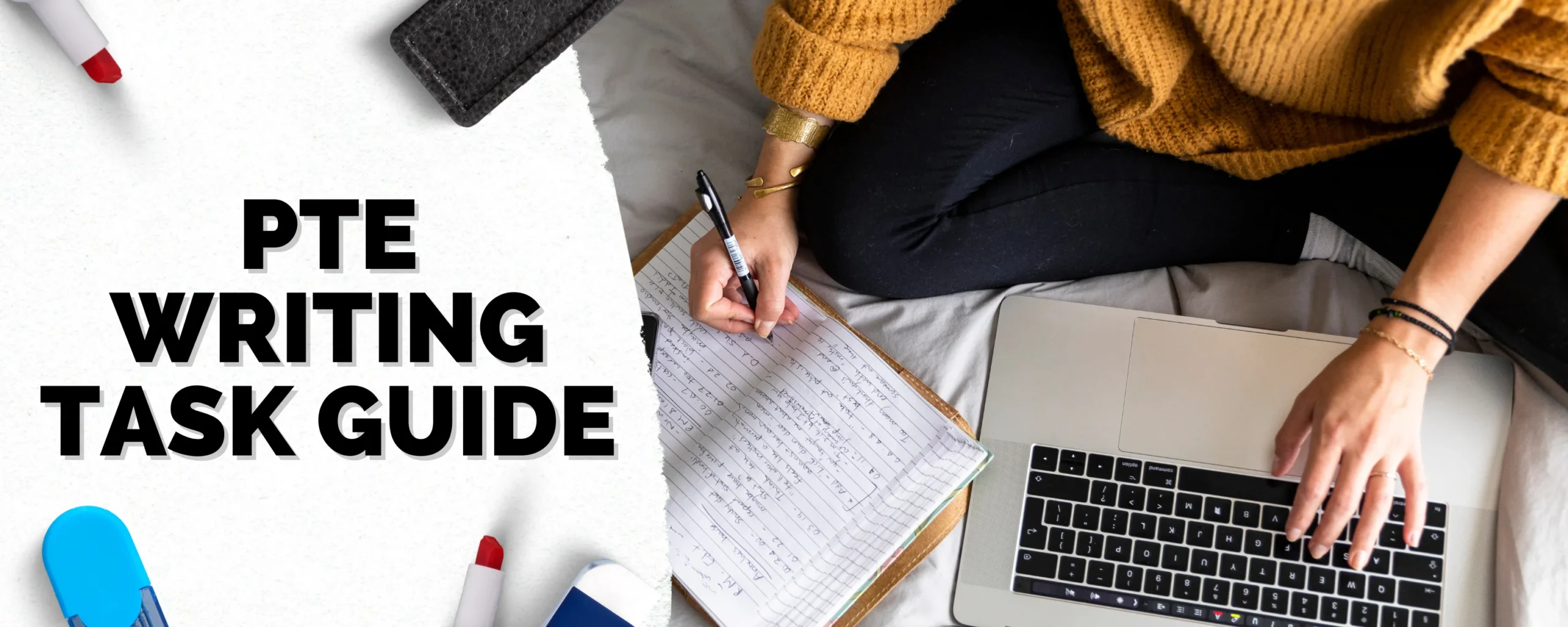The writing section of the PTE Academic assesses how well you can communicate your ideas in writing. Effective strategies will help you present your responses in a clear and persuasive manner. Mastering these strategies will enable you to demonstrate your English proficiency and achieve a high score in the test.
Understanding the Writing Tasks
Overview of Different Writing Tasks in PTE Academic. The PTE Academic writing section features two primary tasks:
Task 1: Summarize Written Text: For this task, you read a passage and summarise it in a single sentence. The passage, usually 300 to 500 words long, requires you to capture the main idea and key points concisely. This task tests your ability to comprehend and synthesize information.
Detailed Tips:
- Identify the Main Idea: Locate the main argument or point of the passage quickly. Typically, the main idea appears in the introduction or conclusion.
- Highlight Key Points: Identify supporting details that reinforce the main idea, including facts, examples, or arguments.
- Construct a Single Sentence: Create a concise and precise summary that encapsulates the core message of the passage in one sentence. Avoid complex or lengthy sentences.
Task 2: Essay Writing: For this task, you receive a prompt and write an essay of approximately 200 to 300 words. Your essay should present a clear argument or analysis in response to the prompt. This task evaluates your ability to organise and express ideas clearly, supported by relevant evidence.
Detailed Tips:
- Understand the Prompt: Read and interpret the prompt carefully to ensure you address all aspects of the question.
- Develop a Thesis Statement: Clearly state your main argument or position on the topic.
- Organise Your Essay: Structure your essay with an introduction, body paragraphs, and a conclusion. Each body paragraph should focus on a specific point, supported by evidence or examples.
- Use Evidence Effectively: Provide specific examples and evidence to support your arguments, demonstrating critical thinking.
Planning Your Writing
Strategies for Preparing and Organising Your Ideas. Effective planning ensures a well-organised and coherent response. Follow these steps:
Analyse the Prompt: Break down the prompt to understand its requirements. Identify key terms and instructions, and determine the type of response needed—whether it’s an analysis, argument, or summary.
Detailed Tips:
- Highlight Keywords: Mark important terms in the prompt to focus on.
- Clarify Requirements: Understand what type of response is expected—whether descriptive or critical.
Brainstorm Ideas: Generate ideas related to the prompt, considering various angles and examples.
Detailed Tips:
- Use Mind Mapping: Create visual diagrams to organise your thoughts and identify connections.
- List Supporting Evidence: Note specific examples or evidence to support your points.
Create an Outline: Draft a clear outline with an introduction, body paragraphs, and a conclusion. For summarisation, outline the main idea and key points. For the essay, outline each paragraph’s main point and supporting details.
Detailed Tips:
- Detailed Paragraph Structure: Outline the main idea for each body paragraph and the evidence you’ll use.
- Time Allocation: Allocate time for planning, writing, and reviewing to avoid rushing.
Allocate Time: Manage your time effectively to complete the task within the given timeframe.
Detailed Tips:
- Time Management Techniques: Set timers for each writing stage to stay on track.
- Practice Under Timed Conditions: Regularly practice under timed conditions to improve time management skills.
Structuring Your Response
Guidelines for Writing Clear and Coherent Responses. Structure your response to enhance clarity and coherence:
Introduction: Start with a clear introduction that sets up the context and purpose of your response. For essays, include a thesis statement or an overview of your argument. For summarisation, state the main idea of the passage.
Detailed Tips:
- Hook the Reader: Begin with an engaging opening.
- State Your Purpose: Clearly outline what you will discuss or summarise.
Body Paragraphs: Every paragraph must to concentrate on a single primary idea. Start with a topic sentence, followed by supporting details and examples.
Detailed Tips:
- Topic Sentences: Begin each body paragraph with a topic sentence introducing the main idea.
- Supporting Details: Provide examples, evidence, or arguments to support each paragraph’s main point.
- Transitions: Use transition words and phrases to guide the reader and connect ideas.
Conclusion: Summarise the main points and restate your thesis or main argument. Reinforce your overall message and provide a strong ending.
Detailed Tips:
- Restate Key Points: Summarise the key arguments or findings.
- Provide a Closing Thought: End with a final thought or reflection.
Coherence and Cohesion: Ensure your writing flows logically with well-connected ideas.
Detailed Tips:
- Linking Words: Use linking words and phrases (e.g., “however,” “furthermore,” “in contrast”) to connect ideas.
- Logical Flow: Ensure that each point leads naturally to the next, maintaining a logical progression.
Grammar and Vocabulary
Tips for Improving Grammar and Using Academic Vocabulary. Strong grammar and a rich vocabulary enhance your writing quality. Improve these aspects with the following tips:
Practice Grammar: Regularly engage in grammar exercises to strengthen your understanding of sentence structure, punctuation, and verb tenses.
Detailed Tips:
- Grammar Workbooks: Use workbooks and online resources to practise common grammar issues.
- Error Analysis: Identify and address recurring grammar mistakes in your writing.
Expand Your Vocabulary: Read academic texts, journals, and articles to expose yourself to a range of vocabulary.
Detailed Tips:
- Vocabulary Lists: Create and review lists of academic vocabulary and phrases.
- Contextual Usage: Practice using new vocabulary in context to ensure proper understanding and usage.
Use Appropriate Academic Language: Maintain a formal tone and avoid colloquial expressions.
Detailed Tips:
- Formal Tone: Use formal language and avoid contractions (e.g., “do not” instead of “don’t”).
- Precision: Choose precise words to convey your ideas clearly.
Proofread for Errors: Always allocate time for proofreading to check for grammar, spelling, and punctuation errors.
Detailed Tips:
- Proofreading Techniques: Read your writing aloud to catch errors you might miss otherwise.
- Use Tools: Employ grammar and spell-check tools as an additional step, but don’t rely solely on them.
Practice and Feedback
Importance of Practicing Writing Tasks and Seeking Feedback. Regular practice and constructive feedback are essential for improving your writing skills. Here’s how to maximise these opportunities:
Write Regularly: Dedicate time each day or week to practising writing tasks, which helps improve your skills and familiarity with the test format.
Detailed Tips:
- Writing Routine: Establish a routine that includes timed practice sessions.
- Varied Topics: Practice writing on diverse topics to build versatility.
Seek Feedback: Share your practice essays and summaries with teachers, tutors, or peers to get constructive feedback.
Detailed Tips:
- Feedback Channels: Use feedback from various sources (e.g., online forums, study groups) to gain different perspectives.
- Act on Feedback: Apply the feedback to make improvements in your writing.
Review Model Responses: Study high-scoring responses to understand what makes them effective.
Detailed Tips:
- Analyse Examples: Break down how model responses address the prompt, structure arguments, and use language.
- Identify Best Practices: Note techniques and practices that you can incorporate into your writing.
Simulate Test Conditions: Practice under timed conditions to mimic the test environment and enhance your time management skills.
Detailed Tips:
- Mock Tests: Take full-length practice tests to familiarise yourself with the test format and timing.
- Stress Management: Develop strategies to manage test anxiety and stay focused during the exam.
Conclusion
Summarising Key Strategies for Writing Success in PTE Academic. To excel in the PTE Academic writing section, focus on understanding the tasks, planning and structuring your responses, improving your grammar and vocabulary, and practising regularly.
Implementing these strategies will enhance your writing skills, boost your confidence, and increase your chances of achieving a high score.
Effective writing develops with consistent practice and dedication.
By staying committed to improving your abilities and applying these strategies, you will be well-prepared for the PTE Academic test. Good luck with your preparation!





